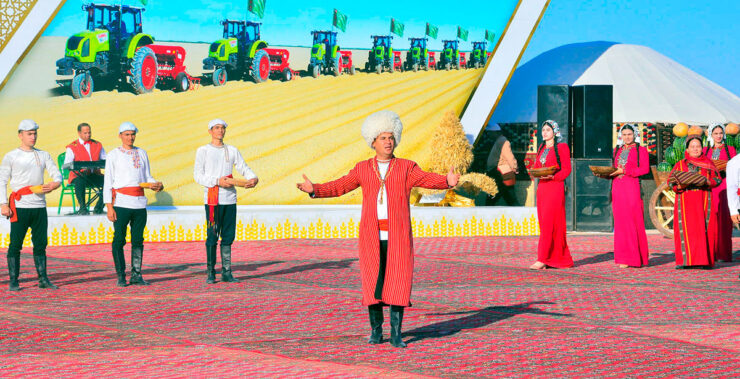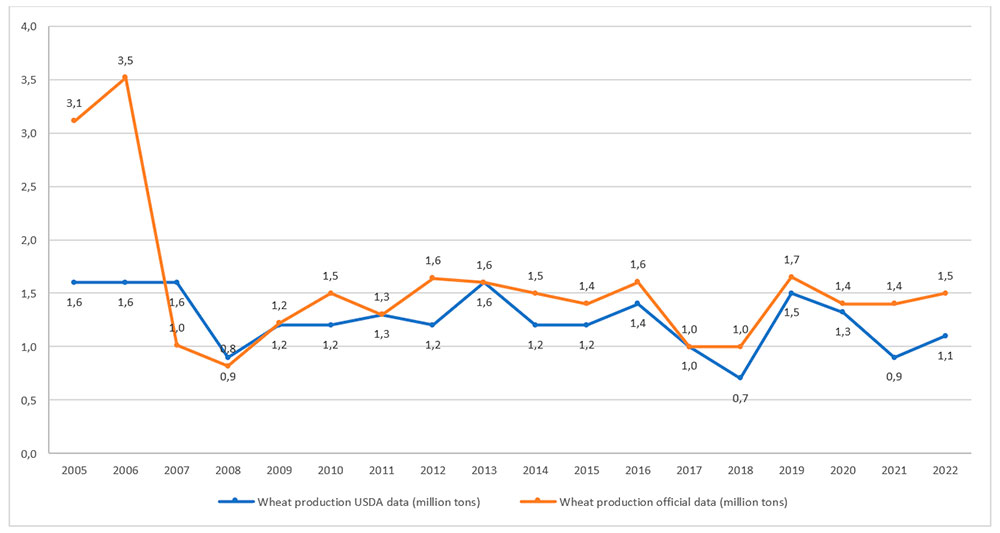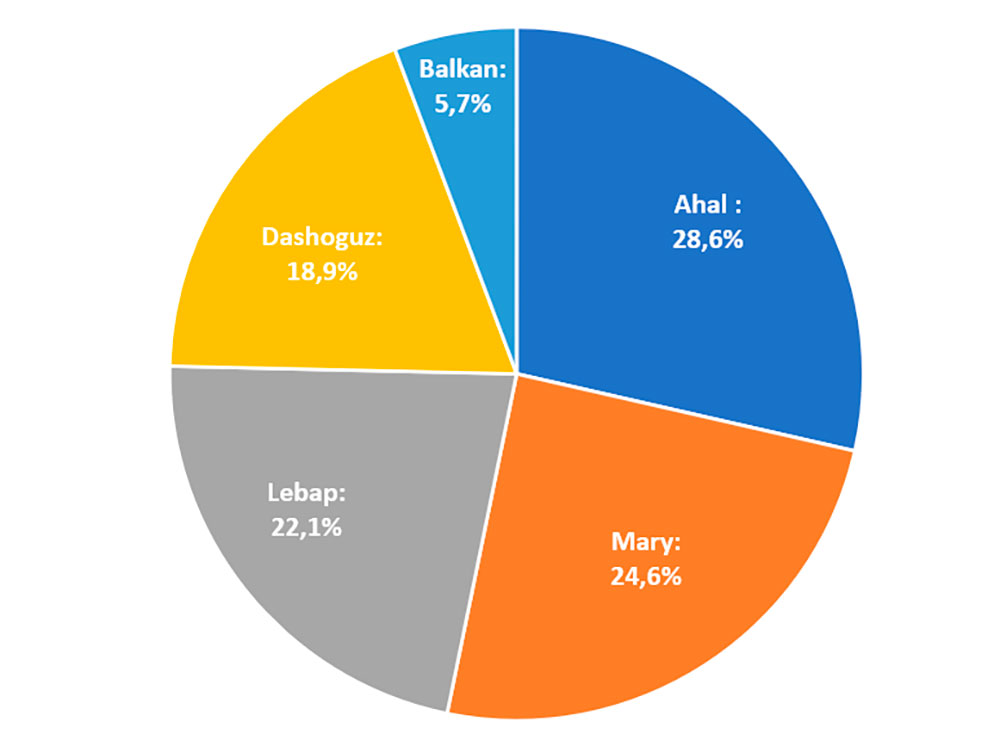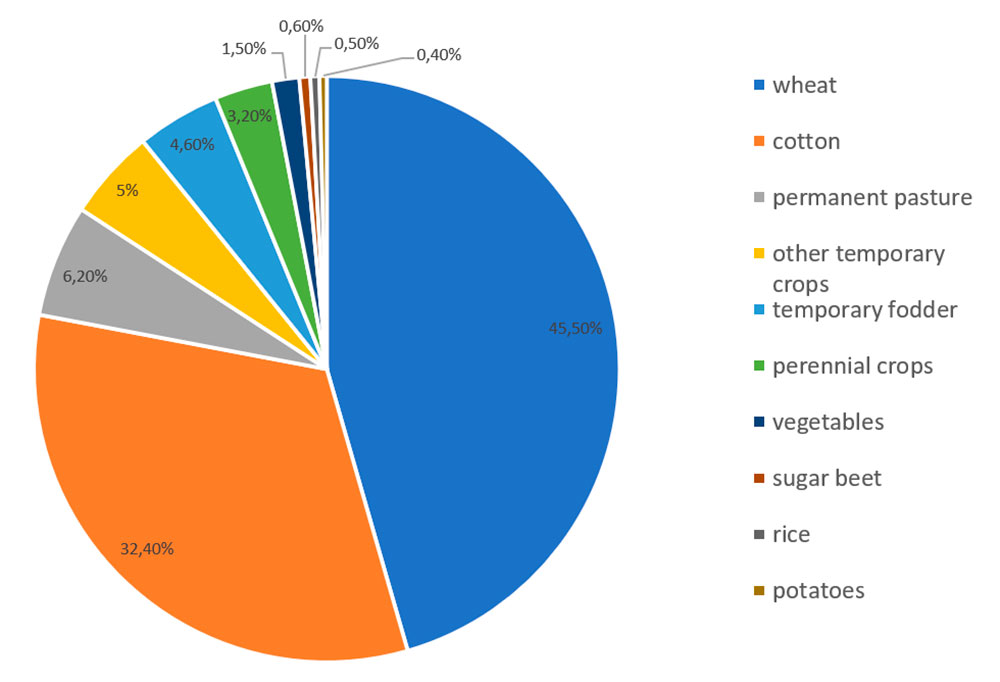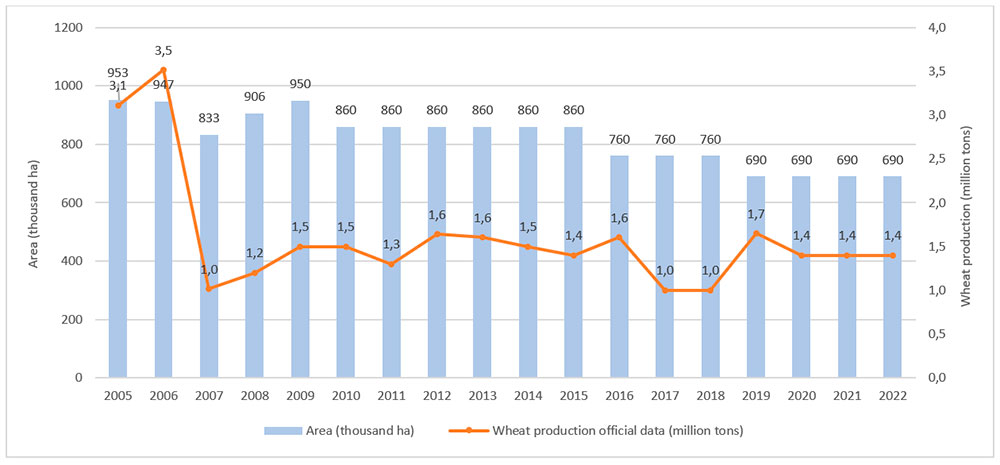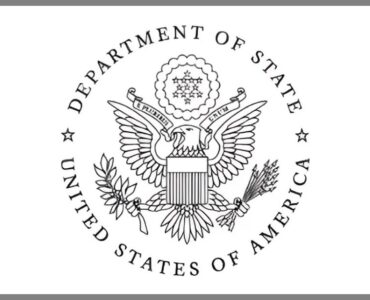Wheat is the most important staple in Turkmen household. Bread is the first thing that is put on Turkmen saçak (a dining table cloth) and the first thing offered to foreign delegates when they step into the Turkmen soil. But in the absence of reliable harvest data and claims about meeting production quotas, it is extremely difficult to know if Turkmenistan produces sufficient volumes of wheat and whether the long lines for bread is the concern of the past. This article aims to shed some light on the topic by summarising publicly available data on wheat production in Turkmenistan.
What is the annual production of wheat in Turkmenistan?
Turkmenistan is the only country in Central Asia where the government controls the whole wheat value chain, from cropping to processing all the way to distribution. The land is state owned. The government decides on the share of land to be used for wheat cultivation, sets the production quota as well as the price at which wheat is bought from the farmers.
The State Statistics Committee and Ministry of Agriculture do not share any data on wheat production in Turkmenistan. However, bits and pieces of data is sporadically shared on various media outlets which is summarized in Figure 1. The chart compares data from the US Department of Agriculture, which also collects data and gives forecasts on wheat production in Turkmenistan, with the official data. Here, official data refers to wheat production data which authors have collected from publicly available sources, most of which cite official statistics shared by the Turkmen government. It covers the following years – 2005, 2006, 2007, 2008, 2009, 2010, 2011, 2012, 2013, 2014, 2015, 2016, 2017, 2018, 2019, 2020, 2021 and 2022. Overall, the US Department of Agriculture reports slightly lower volumes of wheat production compared to what had been shared by the Turkmen government.
Figure 1. Wheat production in Turkmenistan according to data from the US Department of Agriculture and official data from Turkmenistan (in million tons)
Source: United States Department of Agriculture (USDA) and official data – wheat production data collected from publicly available sources which cite Turkmen government data.
In 2022, Turkmenistan harvested 1,500 thousand tonnes (or 1.5 million) of wheat. Over the years, however, the wheat production has fluctuated and on average it has decreased. In 2020 government set the territory for wheat production as 690 thousand ha and the quota for wheat at 1.4 million tons which stayed the same for the past three years, 2020-2022.
Wheat production is not the same across the five regions. As illustrated in Figure 2 Ahal region accounts for the largest share while Balkan region accounts for the smallest share of wheat production.
Figure 2. Share of wheat production by five velayats in Turkmenistan in 2021 (total production was 1.4 million tons)
Source: Business Turkmenistan (BT)
Do farmers meet the annual production quotas for wheat?
Turkmen government continues the Soviet practice of imposing wheat quotas every year. Figure 3 compares the official quota set for wheat production and the actual volumes of wheat that was produced, both as reported by official sources. Few things stand out. First of all, in 2005 and 2006, according to the government, the amount of wheat harvested was almost three times more than the initial objectives. Secondly, only in 2009, 2012, 2016, 2020 and 2021 farmers met the exact quotas and in 2022 slightly exceeded the quota set by the government. While the reliability of this data is questionable, even then it is obvious that farmers are unable to meet the targets set by the government. Thirdly, in 2007, the year when Turkmenistan’s first president Saparmurat Niyazov passed away, the government for the first time did not set any quota. Local farmers produced close to 1 million ton of wheat, which was significant drop from 3.5 million produced a year before. This may be somewhat close to the realistic volumes as farmers had no expected targets to meet.
Figure 3. Comparing the government quota set for wheat production and the actual production numbers
Source: Wheat production data collected from various media outlets which cite Turkmen government data.
Turkmen government’s priority is to ensure food self-sufficiency by focussing on key food products. Wheat and rice are the main traditional crops cultivated to ensure food security. In 2006, total harvested irrigated cropping area was an estimated 2,013,800 ha of which 45.5% (or 917,000 ha) was allocated for wheat (see Figure 4). However, overtime the land was taken away from wheat cultivation and allocated to cotton production, which is a much more profitable crop.
Figure 4. Total harvested irrigated cropping area of 2,013,800 hectares and share of land used for major crops 2006
Source: Food and Agriculture Organisation
Donate to support Turkmen analysts, researchers and writers to produce factual, constructive and progressive content in their efforts to educate the public of Turkmenistan.
SUPPORT OUR WORKAs illustrated in Figure 5, the area of land being used for wheat production has shrunk overtime. It dropped from 953,000 hectares in 2005 to 690,000 hectares in 2022, which is 28% decrease. However, cultivating larger area of land did not necessarily lead to larger volumes of wheat production. For example, the largest amount of wheat, 3.5 million tons, was produced in 2006 using 947,000 ha of land, meanwhile in 2009 using almost the same hectares of land farmers produced only 1.5 million tons.
Figure 5. Comparing the area of land used for wheat production and the volume of wheat produced in Turkmenistan
Source: Compiled from official media sources in Turkmenistan
Using the data for 2022, on average Turkmen farmers harvest 2 ton of wheat per 1 ha of land. To put things in perspective, the average wheat yield for leading wheat producing countries is 4.48 tons per hectare and for Kazakhstan it is 1.10 tons per hectare in 2022.
Can Turkmen farmers make money from producing wheat?
Growing and harvesting wheat has costs related to cultivating the land, and paying for seed, fertilizers, agricultural machinery, labour among other things. In 2018 the cost of cultivating wheat from 1 hectare of land was 925 manat. The government paid 476.85 manat or the 52% of the cost while the lessee (farmer) paid the remainder. In 2019, following the President Gurbanguly Berdimuhamedov’s decision, the full cost of 1 hectare wheat cultivation was set at 1449.77 manats. The government covered 53% of the cost (or 762.23 manat) and the farmer paid the remaining amount.
In 2019 the state purchase price of wheat in Turkmenistan was doubled, increasing from 400 manats to 800 manats per ton of wheat. In official exchange rate this would equal to USD 228.6. In comparison, the wholesale price of 1 ton of wheat in Kazakhstan was 50,000 tenge or USD 131, based on the average USD/tenge exchange rate in 2019. While it looks like Turkmen farmers are making a decent income from growing wheat, compared to their Kazakh peers, the actual income drops to USD 41 when considering the black-market rate.
In 2022 the President of Turkmenistan set a special price for wheat produced in excess of the state mandate. Every extra ton of wheat would be bought by the government at a price of 1,600 TMT/ per ton. This is USD 457 according to official exchange rate or USD 82 based on black market rate. However, it is extremely difficult to reach the mandated quota, let alone to produce extra. Also, this price is twice as much as the regular price at which government buys wheat from local farmers.
Additional information on wheat production in Turkmenistan
Turkmenistan ranks 45th in wheat production in the world with a share of 0.17%. According to the Food and Agriculture Organisation (FAO) from 2009-2013 Turkmenistan imported, on average, 110,000 tons of grain products including wheat. It increased to 122,000 tons in 2013-2014 and 141,000 tons in 2014-2015. Wheat was the 55th most imported product in Turkmenistan amounting to USD 15.1 million in 2020. The country imports wheat primarily from: Kazakhstan (USD 12 million) and Russia (USD 3.11 million).
Given the limited water resources for irrigation, Turkmenistan grows a soft, white wheat. It imports hard wheat from Kazakhstan to blend in order to produce a higher gluten flour suitable for making bread and related products. In 2022 (January-July) Turkmenistan imported nearly 218 thousand tons of wheat from Kazakhstan.
Turkmenistan has also started exporting wheat in 2011 when it reached a point at which country was producing more than necessary to meet the domestic consumption. One of the main buyers of Turkmen wheat is Afghanistan which imported 262,900 ton of wheat in 2017 and 59,040 ton in 2016 as well as wheat flour 1,500 ton in 2017 and 34,952 ton in 2016.
However, international experts and alternative media outlets express scepticism about statistics on wheat production shared by the Turkmen government and official media outlets. Alternative media sources claim that in 2018, for example, Turkmenistan harvested three times less wheat than it was announced by the official media.
Do you believe in official statistics on wheat production in Turkmenistan? Based on your experience and experiences of your family and friends in Turkmenistan, do you think the country produces enough wheat?
Image: Turkmenistan Altyn Asyr

